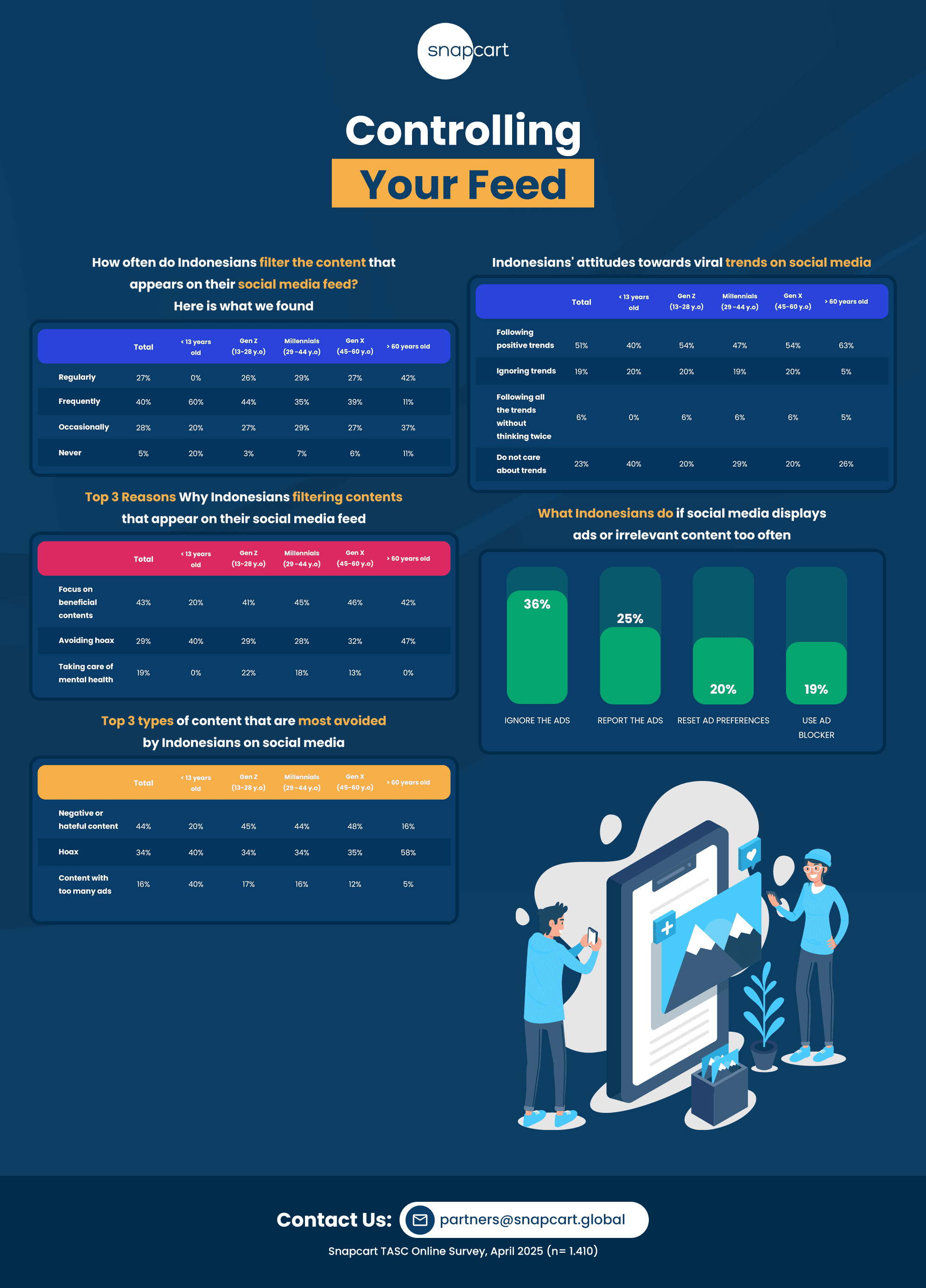In an age where digital consumption is a daily habit, many Indonesians are beginning to take a more intentional approach to the content they engage with online.
Hence, in April 2025 with 1.410 respondents, we tried to deep dive into how people across various age groups in Indonesia are filtering and managing what shows up on their social media feeds. Check out the study result below.

Filtering social media content is no longer a niche behavior—it is becoming the norm. According to this survey, 40% of Indonesians frequently filter the content that appears on their feeds, and another 27% do so regularly. This shows a strong tendency toward curating one’s online experience. Interestingly, age plays a major role in these habits. For example, younger users under 13 are the most active, with 60% saying they frequently filter their feed. On the other hand, older users (60+ years old) are also quite involved, with 42% filtering regularly. Millennials and Gen Z also show significant engagement in filtering practices, reflecting a digitally literate and aware population that values relevance and accuracy in their content.
The motivations behind content filtering vary, but three key reasons emerged. The most common reason, cited by 43% of respondents, is the desire to focus on beneficial content. This shows that Indonesians want their feeds to be useful, informative, and inspiring. The second most common reason is to avoid hoaxes and misinformation, with 29% of users aiming to steer clear of deceptive or misleading content. This is especially true among older users, who may be more vulnerable to online misinformation. Lastly, 19% of Indonesians filter their feeds to take care of their mental health.
The most avoided contents by Indonesians on social media
Avoidance behavior tells us just as much about digital preferences as engagement does. The top type of content Indonesians avoid is negative or hateful content, with 44% saying they steer clear of such posts. This is especially pronounced among millennials and Gen X users, indicating a shared desire for positivity in digital spaces. Hoaxes come in second, avoided by 34% of respondents, with a notable 58% avoidance rate among users aged 60 and above. This reflects a heightened awareness of misinformation and its potential consequences. Lastly, 16% of Indonesians say they avoid content with too many ads, particularly among younger users under 13, where 40% report being turned off by ad-heavy posts. These preferences show a user base that values truthfulness, civility, and content that respects their time and attention.
Additionally, when facing ads or irrelevant content too often on social media, Indonesian users respond in various ways. The most common reaction, at 36%, is simply to ignore the ads. However, many people in Indonesia take more direct action: 25% report the ads to the platform, 20% reset their ad preferences to fine-tune their experience, and 19% go as far as using ad blockers. These actions reveal a clear demand for a more personalized and less intrusive digital experience, where users are not constantly bombarded with irrelevant promotions.
Indonesians’ attitudes towards viral trends on social media
“Viral trends dominate timelines, but unlike the popular stereotype that describe many Indonesians are often driven by FOMO (Fear of Missing Out), our study discovered that Indonesians do not actually follow them blindly. This research figured out that 51% of Indonesians follow only positive trends, suggesting that users are becoming more selective about the types of viral content they engage with,” said Anggia, Research Manager of Snapcart, in Jakarta (12/4).
Meanwhile, this study also discovered that 19% prefer to ignore trends altogether. A small number (6%) admit to following all trends without thinking twice, though this behavior is much more common among the older population (60+). Notably, 23% of users say they simply don’t care about trends, with this sentiment especially strong among users younger than 13 (40%). These figures indicate that while trends shape the social media landscape, many users are choosing to focus on content that aligns with their personal interests and values.
For more information, contact us at partners@snapcart.global or anggia@snapcart.global.





